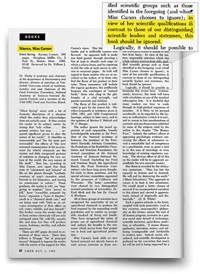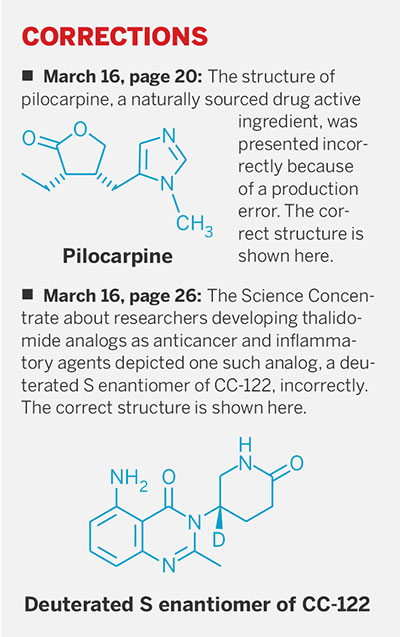Advertisement
Grab your lab coat. Let's get started
Welcome!
Welcome!
Create an account below to get 6 C&EN articles per month, receive newsletters and more - all free.
It seems this is your first time logging in online. Please enter the following information to continue.
As an ACS member you automatically get access to this site. All we need is few more details to create your reading experience.
Not you? Sign in with a different account.
Not you? Sign in with a different account.
ERROR 1
ERROR 1
ERROR 2
ERROR 2
ERROR 2
ERROR 2
ERROR 2
Password and Confirm password must match.
If you have an ACS member number, please enter it here so we can link this account to your membership. (optional)
ERROR 2
ACS values your privacy. By submitting your information, you are gaining access to C&EN and subscribing to our weekly newsletter. We use the information you provide to make your reading experience better, and we will never sell your data to third party members.
Environment
DDT’s Changing Face
Pesticide introduced in the 1940s has played a significant role in U.S. history
by Deborah L. Swackhamer
March 4, 2013
| A version of this story appeared in
Volume 91, Issue 9

Who among C&EN readers has not heard of DDT? Most readers may know it by one of its many names: dichlorodiphenyltrichloroethane, “the miracle chemical,” “the killer of eagles,” the “poster child” of modern synthetic organic chemicals. But few people know the full and complex story of DDT, and fewer still know the story of DDT within the context of our modern history.
In “DDT and the American Century: Global Health, Environmental Politics, and the Pesticide That Changed the World,” David Kinkela, a historian at SUNY Fredonia, tells the biography of this important player and its role in the transition of the U.S. and the world from World War II to the present day. This rich and interesting story emphasizes the role of DDT in postwar U.S. military and foreign policy; the subsequent development of environmental policy; and DDT’s role in the multidimensional intersection of public health, modern agriculture, and global security. He makes a compelling case for how this one chemical influenced the U.S. and the world in numerous ways and at critical points in time over the past 60 years.
In the first chapter of “DDT and the American Century,” Kinkela sets the stage for the remaining six chapters of the book. He describes the discovery of DDT’s insecticidal properties in 1939 by Swiss chemist Paul H. Müller and the quick and extensive investment by the U.S. in developing the use of DDT to prevent malaria and typhus in Allied soldiers during the war. The pyrethroid insecticide used previously by the military for this purpose was mostly provided by Japan. After the war, the potential for DDT to be used to fight insect-borne disease on a global scale was seized on as a technological advance that could improve the world.
Chapter 2 picks up this story, placing DDT as a primary actor in the unfolding of the American Century. Henry R. Luce, whose stable of magazines included Fortune, Life, and Time, wrote an essay entitled “The American Century,” which recognized the new prominence of the U.S. on the global stage and promoted the use of the nation’s superiority in science and technology as a means to influence and improve other nations around the globe.
Using his magazines (particularly Life), Luce conveyed the successful story of American-led malaria eradication programs in Naples and Sardinia in postwar Italy. Pictures captured images of U.S. soldiers and health professionals helping to greatly improve the public health of these war-torn and impoverished areas with DDT spraying, thereby facilitating the creation of the U.S. persona as a benevolent and paternalistic leader in international development.
Throughout the Cold War era, a strong global public health campaign was seen as critical to U.S. foreign policy and to our role in helping provide aid to the developing world. DDT’s use in eradicating malaria was a central element in that campaign. Kinkela provides a detailed view of the political philosophies of the time along with the central role of DDT in implementing the widely held view that aid in the form of public health improvement in developing countries was critical to the U.S. role as a world power. He also introduces the complexities and fallibilities of depending on DDT alone to achieve this goal.

Kinkela then introduces another major dimension of the story, the role of DDT in modern agriculture and the Green Revolution. This parallels the public health story in that helping developing countries feed themselves using modern agricultural techniques (including synthetic organic pesticides) was part of U.S. foreign policy strategy in the Cold War era. DDT is a supporting actor in this part of the story. Ultimately, however, it becomes the focus of the social and legal conflicts between, on the one hand, many supporters of the Green Revolution and the use of technological solutions to exert U.S. influence and, on the other hand, the ecologists and emerging environmental activists who saw this issue through a very different interdisciplinary lens.
The author details the Green Revolution and its start in Mexico, as well as the expansion and integration of this approach into foreign policy. Kinkela documents the very mixed history of the successes and failures of DDT as a “weapon” in the public health wars against insect-borne diseases. He includes a detailed discussion of these World Health Organization programs and their suspension several decades later, largely as a result of the development of DDT resistance by mosquitoes. DDT won many battles, but ultimately the war to eradicate malaria was lost. The author makes the point throughout the book that controversy remains over determining the appropriate places and circumstances where DDT can still be used effectively, as well as whether it should be used given the larger context of benefits gained compared with environmental, economic, and other public health costs.
Enter the publication of “Silent Spring” by Rachel Carson in 1962. This book presented to the public the harmful ecological impacts of synthetic organic pesticides and prominently featured DDT and its harm to wildlife. Kinkela provides considerable detail on the impact of this landmark book on the debate surrounding DDT, how that debate unfolded, and how the various perspectives hardened into vocal and influential warring camps. I was intrigued but not entirely convinced by Kinkela’s argument that, in this debate, DDT’s proponents focused on the Cold War and the fight against communism. Until this point in “DDT and the American Century,” Kinkela’s arguments are nuanced and complex. By contrast, the discussion of the ire raised by “Silent Spring” struck me as more one-dimensional.
Chapter 6 leads the reader through the history of the development of environmental policies of the past 40 years and the regulation and legal actions associated with those policies. Again, DDT plays a leading role both in the creation of the U.S. Environmental Protection Agency in the early 1970s and the passage of landmark federal environmental laws, and in the implementation of those laws in the following decades. The author recounts in detail the early legal battles prior to federal action on DDT, as well as the evolving role of environmental advocacy nongovernmental organizations (in particular the Environmental Defense Fund) and the new discipline of ecology in these battles. When EPA Administrator William D. Ruckelshaus banned the use of DDT in 1972 but did not ban its manufacture or export, he opened the floor to a whole new and contentious debate on the economic, legal, and moral aspects of the international export of pesticides.
The final chapter picks up this theme, placing the discussion of DDT manufacture and use in a larger international context. Unfortunately, Kinkela fails to address the intense discussions and outcomes surrounding the international ban of DDT through the 2001 United Nations Stockholm Convention on Persistent Organic Pollutants. A discussion of this treaty could have been a major element of this chapter, but it is not even mentioned. Kinkela could have provided the history of the development of this treaty; explained why the U.S. and several other nations have not ratified it; and described the impact the treaty has had on global public health, food production, and evolution of international environmental policies and attitudes. This omission is a major shortcoming.
Kinkela withholds judgment on whether DDT was a savior or a villain in our recent past. Providing a solution to the conundrums that DDT presents to the conflicting needs of our world’s diverse societies was never his intent in “DDT and the American Century.” Rather, he sheds light on the complexity and challenges of managing global chemicals under domestic environmental policies. He acknowledges the difficulties of promoting Green Revolution policies and global public health initiatives without a much broader contextual understanding of the culture, the land, and the local environment. He also explores the unintended consequences of a myopic notion that one “weapon” will win any war.
I found that his excellent research and fair handling of the facts kept me interested, rather than frustrated, that my own views of DDT were not being reinforced. I enjoyed reading this book as much as I appreciated learning from his historical rather than science perspective.
The book ends on a disappointing note, though. I had hoped after all the rich presentation of his argument that he would give a summary of the lessons learned for present and future considerations. He chose to end by sidestepping this issue, stating that whether such lessons have been learned, or what the role of DDT in the next century might be, is unclear. I expected more from the final chapter of what otherwise is a well-written and interesting book. Environmental scientists, chemists, legal scholars, and historians from all perspectives would benefit from reading this book.
Deborah L. Swackhamer is a professor in the department of environmental health sciences in the School of Public Health and the department of science, technology, and environmental policy in the Humphrey School of Public Affairs at the University of Minnesota, Twin Cities.




Join the conversation
Contact the reporter
Submit a Letter to the Editor for publication
Engage with us on Twitter